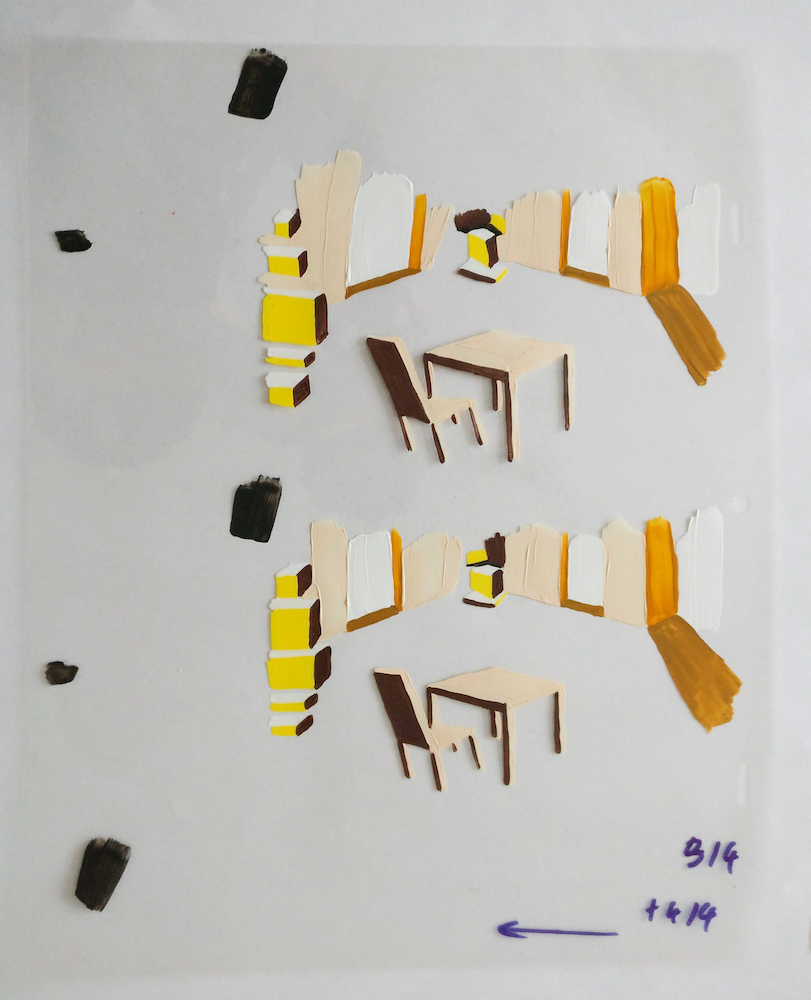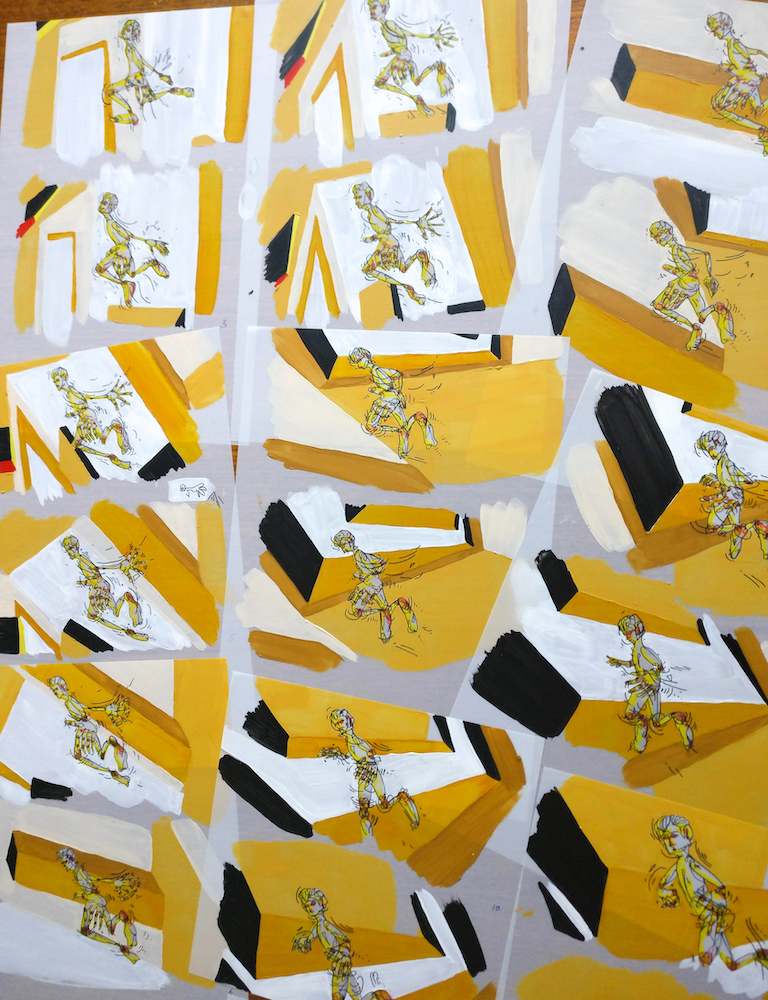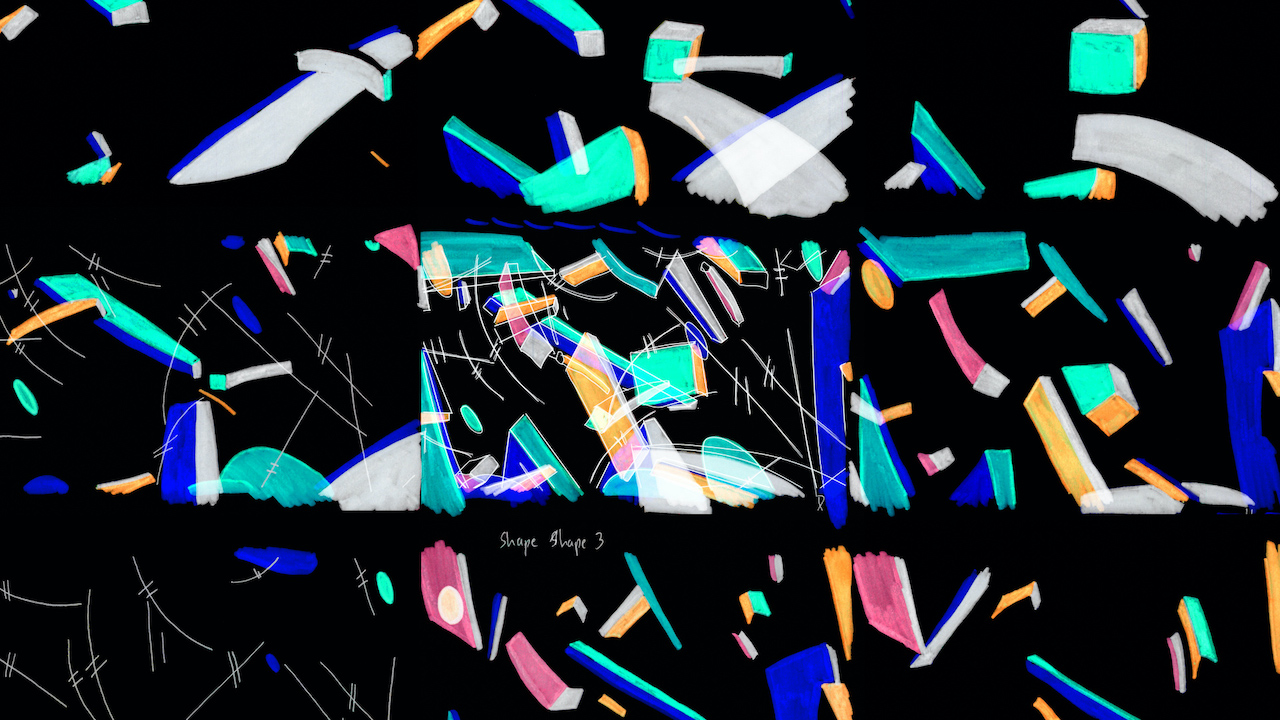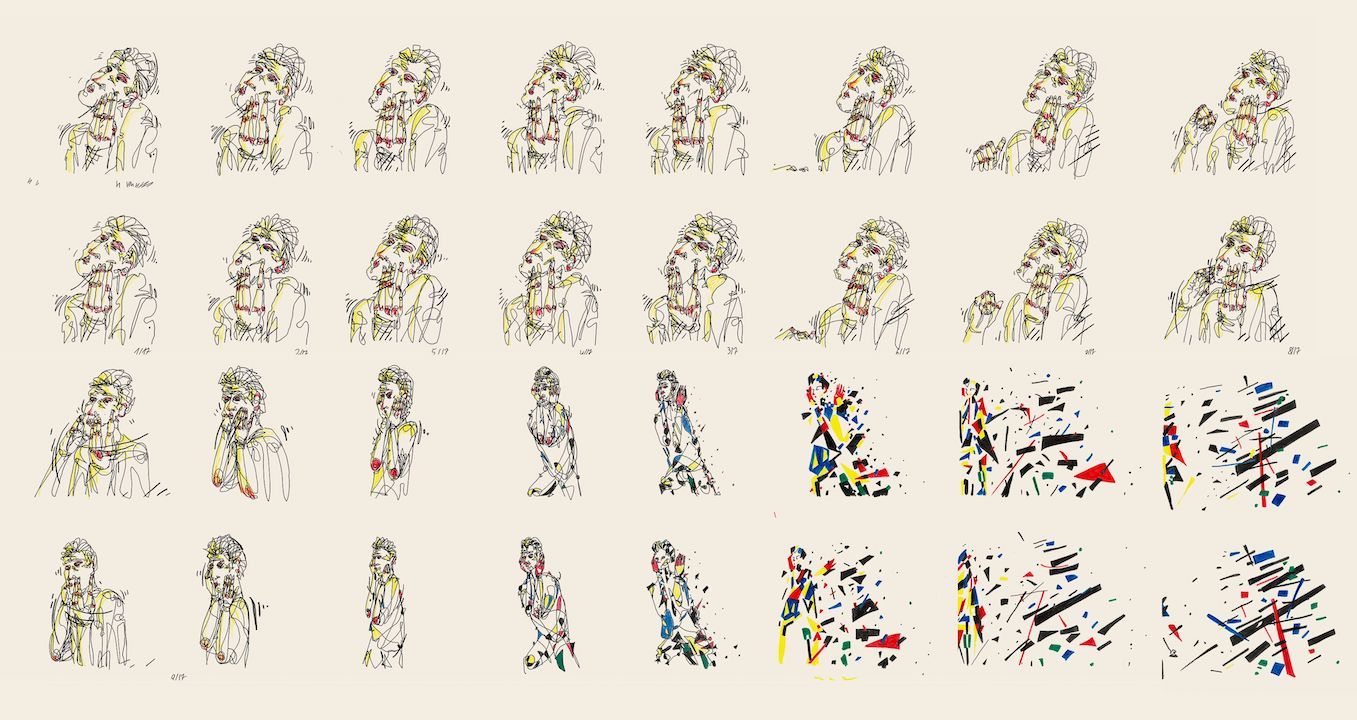
We’ve seen a wide range of themes/subjects tackled in short film (the freedom the format allows is one of the main things I’ve always loved about shorts), but I’m not sure I’ve seen anything as ambitious as Michelle Brand attempting to “discuss and visualise our perception of time” in her five-minute Royal College of Art grad film Any Instant Whatever. A hypnotic, mesmerising short, which played Annecy, Encounters and Palm Springs in 2020, narratively Brand’s short focuses on a man and a falling chair, but thematically it aspirations are much grander. Eager to discover what influenced such a philosophical approach to her filmmaking, Brand joins us to discuss non-existent happenings, philosopher Henri Bergson and why animation was the perfect medium to explore theories of time, movement and change.
Having watched Any Instant Whatever a couple of times now, it feels like a difficult film to summarise. How do you best explain the film and its subjects to someone who hasn’t yet watched it?
I would say the film attempts to discuss and visualise our perception of time – but if somebody asks me ‘Oh, I watched xy programme, what was your film?’ I usually say it’s that one animation with just one person in a room at a table and a chair falling. It’s not really the storyline, but most people tend to remember the chair or the fact that nothing really happens for a while and it’s just a person sitting there. I think both versions are a good description, one that’s conceptually super broad and one that narratively describes a sort of non-existent happening.

You tackle some large philosophical ideas – time, change, etc. – within the film’s tight 5-min duration, what was your motivation to explore such grand themes?
I’ve always been fascinated by the connection of animation theory and philosophies on time, and the film is sort of a result of two dissertations I wrote about this connection. This is actually where the title comes from too – philosopher Henri Bergson came up with this wonderful term ‘Any Instant Whatever’ to describe the idea that time consists of indifferent, and interchangeable instants, but that these instants are indivisible because they pass from one to the next, like in a melody, where it is impossible to extract any tune.
If everything is constantly changing, where am I at any moment in time?
After these dissertations, I really felt the need to make a film about this idea. In a way, for me, the film is a visual exploration of questions, thoughts and discussions I was having in my head at the time about these ideas. It especially was a time full of changes, which within this discussion made me wonder “If everything is constantly changing, where am I at any moment in time? Is there such a thing as a self if it’s continuously becoming, transitioning and moving on?” and the film became a platform for me to process these thoughts.

In your director’s statement you describe animation as the “perfect tool” for exploring these aforementioned ideas, can you expand on why this is so? I’m particularly interested in whether you think this film could work as a live-action piece?
I think you could make something similar through a live-action piece which concentrates for example on single-frame editing and messing up the timeline of movements. It actually certainly would be quite interesting, as it can discuss this idea that you are recording a movement that previously existed, but segmenting it spatially, making the reality and time recorded divisible – there would be much to discuss and experiment with!
But what makes animation even more useful for dissecting notions of time, in my opinion, is that the movement in animation often isn’t extracted from movement previously recorded. In some sense, one could even say animation creates and extracts movement from a body that does not yet exist prior to its screening and this movement is created out of nowhere through a succession of frames with an increasing amount of change on each frame – isn’t that in itself a fascinating idea! It already contains in a practical manner the one connection that you find most often in philosophical discussions on time – that time, movement and change are inseparable – without one, not the other – and that’s exactly how animation works.
Animation exists through discontinuity, yet we perceive it as continuous.
Often philosophers, such as Henri Bergson, argue that we exist through continuity, that time is continuous and indivisible, yet we perceive duration as discontinuous. However, animation exists through discontinuity, yet we perceive it as continuous. This contrast in perception and reality is what I think makes animation such a fascinating and adequate tool to raise philosophical questions on time, movement and change: A frame in animation usually remains invisible to our eye. The amount of difference in the movement between two succeeding frames can be very large, such as seen in flicker films, or barely perceivable if one compares two still frames next to each other.
The succeeding images are so close to being identical, yet they are not completely the same. I believe this relates remarkably to the philosophical idea that no matter how static one believes something to be, in actual fact, there is a small change constantly happening around us. Yet each animation frame taken out from the whole of the movement, carries no meaning by itself, just like the tune in a melody you can’t extract. I think this is a wonderful way of thinking about time.

Since we’re talking about animation, I wanted to focus on your aesthetic some more. Any Instant Whatever looks like a largely hand-crafted piece can you provide us with some insight into your production methods?
Except for some scenes, the film was first animated very roughly digitally, and then each frame was printed out and then redrawn with different materials – pens/paint on paper, or paint on cell. This was necessary for me to be able to first just play around with the scenes, as much as I wanted, before I painted them and wasted days on a scene I wouldn’t include. There was some storyboarding involved, but the film was very much a constant puzzle of putting shots in a certain order.
There actually was a very strict structure that I had developed that helped me decide when what would happen, as I had a lot of coordinates to play with that develop throughout the film: There is the coordinate of time and movement (how fast/slow are things moving? Are we inbetweening properly or are we flickering frames?), the coordinate of materiality and texture (the beginning of the film is drawn very solid, and dry with paint on paper, things are very still. Later it’s paint on cell, it feels more wet) and finally, of course, the coordinate of visual style (Is the character drawn very solidly or very loosely? How abstract is the background? What colours?).
Whereas often narrative films have a story arc they follow, I was following these ‘coordinate arcs’ in form of different graphs that helped me be able to place everything in a certain order. The really fun bit then was when the production process becomes the content of the film. For example, when you can see 4 frames happening at once on screen, that’s because I would be painting 4 frames on an A4 piece of paper. Or I would leave the frame numbers on the screen and not correct little notes I made on the frames – which was fun, but also a real time saver!


Looking at your previous shorts, I see elements of them (the sketchy figures from Synchronicity, the painterly feel of Not The Same River. Not The Same Man) in this film, what attracted you to the aesthetic you use in Any Instant Whatever? What do you think it adds to the story?
I think it was really important for me to have a real mix of styles, and some of them definitely are influenced by the previous films you mentioned. Since I wanted to describe this idea of continuous change, I believed that having a real mixture of styles was going to help visualise that idea, on top of things moving faster or deconstructing into abstract shapes. I also knew I wanted the film to develop from still, solid, big shapes to an explosion of small abstract shapes – so I needed to develop several styles in between to be able to transition from the stillness at the beginning of the film to the abstract noise at the end.
The person starts to be viewed as just another ever-changing shape.
Having a huge array of changing styles was also important so that my character would feel less like a character with a story, but more like an empty canvas, an embodiment of the concept. The person then starts to be viewed as just another ever-changing shape within the room, until only pure movement remains.

Sound feels like it plays an important role in the success of the short and looking through your credits I was impressed to see you took on the sound production for your film yourself. How did you approach the soundtrack? What was your aim with the score?
I had so much fun with the sound design. As I mentioned earlier, there are these textural changes that happen throughout the film, and I wanted to have the sound design underline that idea as well. So one day I walked into the sound studio at our university with bags full of random stuff – sand, leaves, glass, wind chimes, drums, wood sticks, rice, plastic bags, marbles… And I just recorded everything and anything I could think of. Then came the tricky part of creating a rhythmical sound piece that wasn’t too melodic, yet dynamic. I didn’t want the sound to suddenly burst into a rhymical piece of crazy drums, but the sound should constantly feel new, unexpected and have no reoccurring melody.
I used a program called Sound Particles to create very unexpected effects combining different textural sounds together, without knowing myself what the result was going to be, it’s like a 3D particle program just for sound design. So in a way, I was recording multiple ‘takes’ and then took whatever worked. But I also had an immensely talented and amazing sound mixer, Ed Rousseau, who also helped me with the sound design a bit and really pushed everything all so much further, I owe a lot to him.


Ok, final question about the film – considering it tackles these quite imposing, grand ideas what do you hope a viewer takes away from watching it?
I hope they simply enjoy the explosion of shapes and transition of forms because, in a way, that is part of the main concept – that nothing is as still as we believe. I don’t expect anybody to watch the film and then recognise all the philosophical concepts that influenced it, but for the viewer to feel the movement, to see things come alive in front of them, to enjoy the journey, to experience the idea that nothing is solid and everything is continuously changing and that’s a wonderful thing – that is what I really hope for.


Before you go, can you tell us a bit about any future projects you have in the works?
At the moment, I’m enjoying some time out from filmmaking and am freelancing, working on all different kinds of projects, which is very exciting. But I do feel that the concepts of Any Instant Whatever could be explored further, I believe this is a never-ending process, but that’s probably a good thing!


